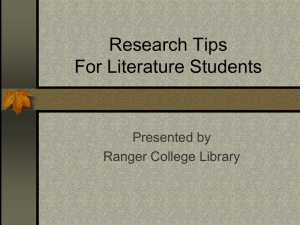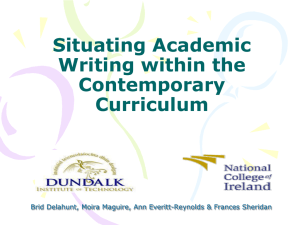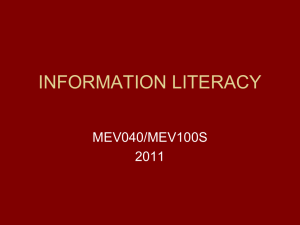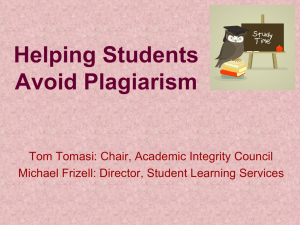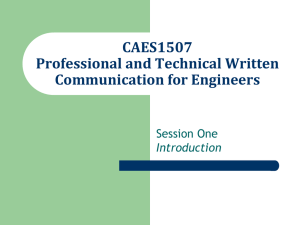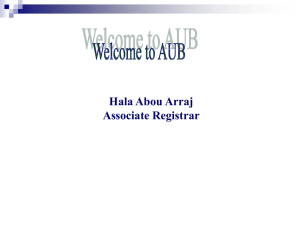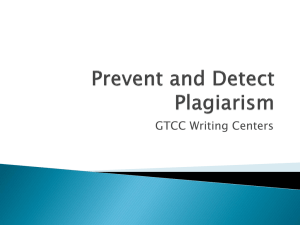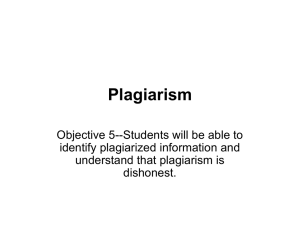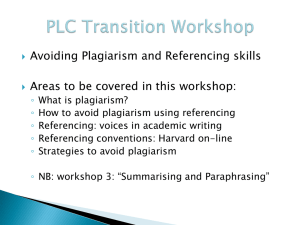Plagiarism : Ignorance amongst first year Public Relations Students
advertisement
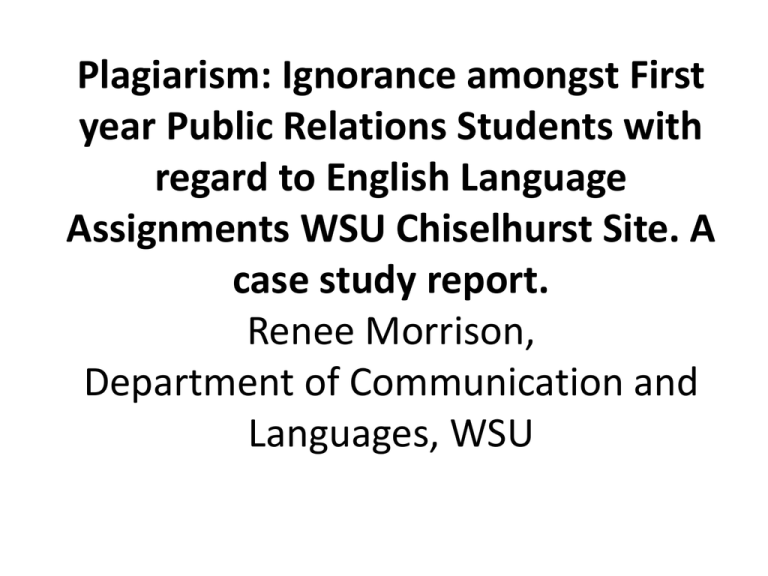
Plagiarism: Ignorance amongst First year Public Relations Students with regard to English Language Assignments WSU Chiselhurst Site. A case study report. Renee Morrison, Department of Communication and Languages, WSU Introduction • Plagiarism in English language assignments 1st PR students WSU, Chiselhurst Site. • Students struggle to use referencing techniques correctly led to committing plagiarism. • Students were requested to research Theories on Ethics and write a report of 1000 words based on their understanding of ethics. • Concern that plagiarism is on the rise due to ignorance and easy access to academic papers on the internet. • 400 colleges and universities have subscribed to an online database called Turnitin.com_ to aid with plagiarism, in North America alone (Canadian Association of University Teachers, 2003). • Realisation that plagiarised source materials are fraudulent are not fully understood. • Similarly the WSU have a plagiarism system called SafeAssign that is built into the elearning WiSeUp system. • Australia in 2005 a research journal was launched to address issues of academic and educational integrity. (Cohen, 2007, p. A51). • Concern that English Second Language (ESL) students may be more vulnerable to accusations of fraud as their inappropriate textual borrowing is a more obvious. (McGowan, 2005; Pecorari, 2003; Valentine, 2006). • L1 and L2 writing researchers have been trying to understand the reasons that might account for unacceptable source appropriation. Literature continue • Student plagiarism, the complexity of the phenomenon, locating it in a web of socio-cultural relations. • Inappropriate source attributions culturally shaped students lives (Abasi, Akbari,&Graves, 2006; Cadman, 1997; Sherman, 1992), their outsider status relative to their prospective discourse communities (Ange´lilCarter, 2000; Chandrasoma, Thompson, & Pennycook, 2004; Currie, 1993, 1998; Pecorari, 2003; Ritter, 2005; Thompson, 2005; Valentine, 2006), or their racial and social positioning excluding them from the rules and conventions of school literacy practices (Hull & Rose, 1989; Starfield, 2002). The Study • “Popular plagiarism”- or everyday nontransgressive intertextuality is an integral part of our life. • Intertextual borrowing as a pervasive social practice. • Politicised information by governments legal. • Social users constructed textual knowledge as common knowledge and use it freely. Theoretical framework • Sociocultural-historical framework focused on both the situated and distributed nature of learning mediated by the cultural artefacts and practices of a community(Brown, Collins, & Duguid, 1989; Vygotsky, 1978; Wenger, 1998; Wertsch, 1994). • Academic writing as a situated activity mediated by institutional discourses and practices (Foucault, 1981; Gee, 1996; Lemke, 1995). Bakhtinian Dialogic Theory of Language • Of particular relevance to this paper is the Bakhtinian dialogic theory of language that brings to the fore the heavily borrowed character of language use as well as the intertextual nature of such use in the sense that all utterances respond to, and anticipate, other utterances (Bakhtin, 1981, 1986; Volosinov, 1973). Method • Qualitative study with 40 students involving marked Assignments and Reflective discussion post marking. • This formed the basis of the data sources. • The research design provided a detailed understanding of the context as well as the experiences of the students in the class. • The process of data analysis was interpretive and attempted to understand what the students considered to be important writing assignments; how they understood referencing, source attribution, and plagiarism. Findings • Although and guidelines to writing the Assignment on Ethics were explained, students did not understand the topic. • The writing assignments were mostly one shot. PR student writers relied completely on the language of the published authors to produce their own texts. • Rules that work tend to be kept, while those that cause confusion eventually get dropped or repaired. Findings: Reflective discussions • “I used the articles ideas because they were so similar to my ideas”(Participant 24). • “I just borrow some others a little bit . . . To be really honest, I didn’t have much time to explore other books in the library or on the internet.” (Participant 4) • “I want to show the lecturer I’ve read the articles. I want to show her I know what all of these articles and books have said” (Participant 21). Recommendations • When writing a paper one should avoid simply weaving together different quotations to tell the story. • Some of the students revealed cultural, educational, and professional dispositions that oriented them differently to text, knowledge, and authorship. These must be explored and addressed. Recommendations Cont. • Students considered the process of source attribution mainly as a formal process. • Need to locate any understanding of textual ownership and plagiarism in academic writing as part of a broader account of institutional regulation, interdisciplinarity, and the mediation of discourse. • SafeAssign programme to become more accessible.
